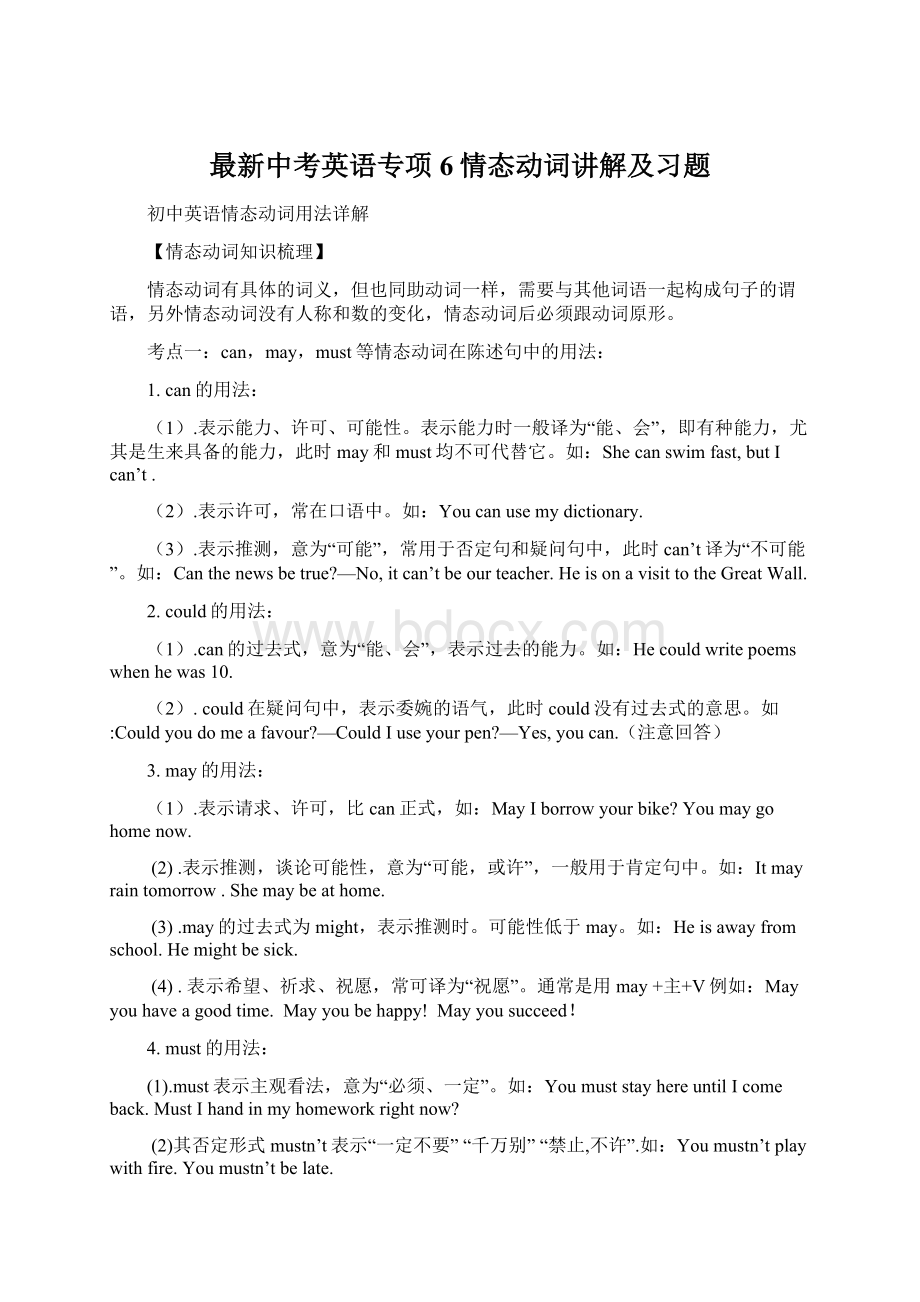最新中考英语专项6情态动词讲解及习题.docx
《最新中考英语专项6情态动词讲解及习题.docx》由会员分享,可在线阅读,更多相关《最新中考英语专项6情态动词讲解及习题.docx(17页珍藏版)》请在冰豆网上搜索。

最新中考英语专项6情态动词讲解及习题
初中英语情态动词用法详解
【情态动词知识梳理】
情态动词有具体的词义,但也同助动词一样,需要与其他词语一起构成句子的谓语,另外情态动词没有人称和数的变化,情态动词后必须跟动词原形。
考点一:
can,may,must等情态动词在陈述句中的用法:
1.can的用法:
(1).表示能力、许可、可能性。
表示能力时一般译为“能、会”,即有种能力,尤其是生来具备的能力,此时may和must均不可代替它。
如:
Shecanswimfast,butIcan’t.
(2).表示许可,常在口语中。
如:
Youcanusemydictionary.
(3).表示推测,意为“可能”,常用于否定句和疑问句中,此时can’t译为“不可能”。
如:
Canthenewsbetrue?
—No,itcan’tbeourteacher.HeisonavisittotheGreatWall.
2.could的用法:
(1).can的过去式,意为“能、会”,表示过去的能力。
如:
Hecouldwritepoemswhenhewas10.
(2).could在疑问句中,表示委婉的语气,此时could没有过去式的意思。
如:
Couldyoudomeafavour?
—CouldIuseyourpen?
—Yes,youcan.(注意回答)
3.may的用法:
(1).表示请求、许可,比can正式,如:
MayIborrowyourbike?
Youmaygohomenow.
(2).表示推测,谈论可能性,意为“可能,或许”,一般用于肯定句中。
如:
Itmayraintomorrow.Shemaybeathome.
(3).may的过去式为might,表示推测时。
可能性低于may。
如:
Heisawayfromschool.Hemightbesick.
(4).表示希望、祈求、祝愿,常可译为“祝愿”。
通常是用may+主+V例如:
Mayyouhaveagoodtime.Mayyoubehappy!
Mayyousucceed!
4.must的用法:
(1).must表示主观看法,意为“必须、一定”。
如:
YoumuststayhereuntilIcomeback.MustIhandinmyhomeworkrightnow?
(2)其否定形式mustn’t表示“一定不要”“千万别”“禁止,不许”.如:
Youmustn’tplaywithfire.Youmustn’tbelate.
(3)对must引导的疑问句,肯定回答为must,否定回答为needn’t或don’thaveto.如:
—MustIfinishmyhomework?
—No,youneedn’t.
(4)must表示有把握的推测,用于肯定句。
如:
Thelightison,sohemustbeathomenow.
注意其反意问句的构成形式:
当must表示肯定的判断、推测时,其反意疑问句要用实际问句的助动词来构成。
如:
Shemusthaveseenthefilmbefore,hasn’tshe?
(注意反意疑问句的后半部分)YoumusthavemetuncleWangintheshopyesterday,didn’tyou?
(注意反意疑问句的后半部分)
5.need的用法:
(1).need表示需要、必须,主要用于否定句和疑问句中,其否定形式为needn’t,意为“没有必要,不必”。
用need提问时,肯定回答为must,否定回答为needn’t或don’thaveto。
如:
—NeedIstayhereanylonger?
—Yes,youmust.—No.youneedn’t/don’thaveto.
(2).need还可以作实义动词,此时有人称、数和时态的变化,如果是人作主语后边多接动词不定式。
如:
Ineedtodoitrightnow.
如果是物作主语,一般用needdoing与needtobedone这种情况下应注意两点:
①.主动形式的动名词doing具有被动的含义;②.该动名词可以改为其动词不定式的被动形式而句子的意义不变。
例如:
.Thedoorneedspainting.=Thedoorneedstobepainted.
6.dare的用法:
dare意为“敢、敢于”,用法近似于need,有两种词性:
(1)dare作为情态动词,多用于否定句、疑问句或条件句中,无第三人称单数形式,只有一般现在时和一般过去时。
如:
Darehetellthemwhatheknows?
Idaren’taskher–willyoudoitforme?
(2)dare作为实义动词,此时有人称、数及时态的变化。
如:
Hedoesn’tdaretobreakhispromise. 注意:
口语中,dare的各种形式常与不带to的不定式连用。
如:
DoyoudaretellherwhatIsaid?
7.shall的用法:
shall表示征求对方意见(多用于第一、三人称),如:
Shallwegooutforawalk?
8.should的用法:
(1).should意为“应该”,可表示劝告、建议、义务、责任等。
如:
Weshouldprotecttheenvironment.
(2)Shouldhavedone表示对过去动作的责备、批评。
如:
Youshouldhavefinishedyourhomework.
9.will的用法:
will表示意愿、意志、打算,可用于多种人称。
如:
IwillhelpyouifI’mfreethisafternoon.
10.hadbetter的用法:
hadbetter意为“最好”,没有人称的变化,后面接不带to的不定式,其否定形式为:
hadbetternot。
如:
Wehadbettergonow.
考点二:
含有情态动词的疑问句的回答:
1.对may引出的问句,可以有下列回答方式:
Yes,youmay.Yes,ofcourse. Yes,certainly. Sure. No,youmustn’t.No,youcan’t.
2.对must引出的疑问句,回答方式为:
Yes,…must.No,…needn’t/don’thaveto.
3.could在疑问句中,表示委婉的语气,此时could没有过去式的意思。
如:
Couldyoudomeafavour?
—CouldIuseyourpen?
—Yes,youcan.(注意回答)
4.shall引出的疑问句用于第一人称,表示征求对方意见或客气的请求。
其回答方式有以下几种:
Yes,please. Allright. No,thankyou.
5.wouldyou…的回答方式有以下几种:
Yes,Iwill.(No,Iwon’t.) Sure.(I’msorry,Ican’t.) Allright/OK/Withpleasure. Certainly.(No,thankyou.) Yes,please.
考点三:
不同情态动词的否定意义也不同:
1.
(1).can’t可译为“不会”,如:
Ican’tplaybasketball.
(2)当句子表推测时,用can’t表达不可能,如:
Hecan’tbeill.HeisplayingchesswithTom.
(3)can’t还可用来回答“MayI…?
”这样的问句。
如:
MayIcomein?
No,youmustn’t./can’t.
(4)can’t还可用于固定习语中。
can’thelpdoing禁不住,情不自禁can’twaittodosomething迫不及待地要做…
2.may的否定式为maynot,译成“可能不”,如:
Hemaynotbeathome.
3.
(1)mustn’t表示不许,不可。
如:
Hemustn’tleavehisroom.
(2)mustn’t也可用于以may表示要求时的否定回答中。
如:
—MayIstandhere?
—No,youmustn’t(can’t).
4.
(1)needn’t意为“不必”。
如:
Youneedn’tmeethimunlessyou’dliketo.
(2)needn’t+have+动词的过去分词,表不需要完成但已完成的动作,暗含时间或精力上的浪费。
如:
Youneedn’thaveboughtit.你没必要买它(但你却买了)。
5.shouldn’t表示不应该。
如:
Youshouldn’tfeelsounhappyoversuchlittlethings.
考点四:
情态动词的被动语态
含有情态动词的被动语态的结构为:
情态动词+be+done(动词的过去分词)。
做题时要兼顾情态动词和被动语态这两个方面。
考点五:
情态动词表示推测的用法:
一、“情态动词+动词原形”表示对现在的推测。
1、can表示推测时一般用于否定句或疑问句。
如:
Thatmancan'tbeherhusbandsheisstillsingle.
2、must表示肯定的推测,一般用于肯定句中。
如:
Hemustbeinhisofficenow.
3、might表示推测时不一定是may的过去时,只是表示其可能性较小。
如:
Themanmaybetheheadmaster.
4、Could表示推测时,语气can比要弱,说话者留有余地。
如:
—Coulditbeananimal?
—Itcouldnotbe,becauseitisnotmoving.
5、Should表示推测的可能性比较大,仅比must的可能性小一点。
如:
Itisalready10o’clocknowtheyshouldbethere.
二、情态动词表示对过去可能发生的动作或存在过的动作的推测性用法。
1、“must+havedone/been------”表示“过去一定发生过某事或存在过某种状态”,不用于“musn’t+have-----”形式。
如:
Shemusthaveseenthefilmbefore,hasn’tshe?
(注意反意疑问句的后半部分)
2、“should+havedone/been-------”表示“本应当做某事,而实际上并没有做”;“shouldn’t+完成式”表示“本来不应当做,而实际上却做了”。
以上结构常带有说话者的责备的感情色彩。
如:
Youshouldhavefinishedyourhomeworkearlier(butinfactyoudidnotfinishitontime).
3、“needn’t+完成式”表示“本来没有必要做某事,而实际上却做了”。
如:
Therewasplentyoftime.Sheneedn'thavehurried.
4、“can’t/couldn’t+havedone/been-------”表示“过去不可能发生了某事或存在过某种状态”。
如:
Isawhimjustnow.Hecan’thavegonetoJapan.
5、“could+havedone/been-------”表示“过去本来能够,可以做某事或成为某种状态,而实际上没有”,说话者有些遗憾。
6、“may/might+完成式”表示“过去可能,本来可以于某事而实际上没有干”,might的可能性较小,语气较弱。
如:
Hemayhavefinishedreadingthebook.
【情态动词易混点归纳】
易混点一:
can和beableto:
两者表示能力时用法相同,但can只有原形“can”和过去式“could”两种形式,在其他时态中要用beableto来表示。
另外beableto常常指经过努力,花费了时间和劳力之后才能做到某事。
易混点二:
can和may
1.can和may均可用来征求意见或许可,意为“可以”,一般可互换使用。
如:
Can/MayIhelpyou?
我能帮助你吗?
2.can和may表示可能性时的区别:
1)在肯定句中用might,may,must,不用can
2)在疑问句中表示推测用can,不用might,may,must
3)在否定句中用can’t(不可能),不用may,must。
如:
Shemaybeintheclassroom.她可能在教室里。
Wherecantheybenow?
他们现在可能在哪儿?
Thatcan’tbetrue.那不可能是真的。
易混点三:
maybe和maybe
用法区别常用位置
maybemay为情态动词,be为动词原形句中,作谓语
maybe副词,大概、也许,相当于perhaps句首,作状语
例如:
Hemaybewrong,butI’mnotsure.也许他错了,但我也不确定。
易混点四:
can’t和mustn’t
1.can’t根据其基本用法可译为:
(1)不会。
如:
Ican’tspeakEnglish.我不会说英语。
(2)不能。
如:
Wecan’tdoitnowbecauseit’stoodark.天太黑了,我们现在干不了。
(3)否定句中表示推测。
“不可能”,如:
Themancan’tbeourteacherbecauseheismuchyoungerthanourteacher..\。
2.mustn’t意为“禁止、不许”,用来表达命令,表示强烈的语气。
如:
Youmustn’tplayfootballinthestreet.It’stoodangerous.
易混点五:
must和haveto
1.must侧重于个人意志和主观上的必要。
haveto侧重于客观上的必要,可用于现在时、过去时和将来时。
易混点六:
usedtodo/beusedtodoing/beusedtodo…/beusedfordoingsth
usedtodo表示过去常常发生的动作,强调过去,只用于过去;而beusedtodoing意为“习惯做…”;beusedtodo意为“……被使用去做……,”为被动语态形式。
beusedfordoingsth“用作……”
练习题一
1.-Mum,mayIwatchTVnow?
-Sure,butyou________helpmewithmyEnglish.
A.canB.mayC.mustD.could
2.-________Idownloadthearticleagain?
-No,youneedn't.
A.ShallB.WillC.MustD.Can
3.-Canyougoskatingwithusthisafternoon?
-Sorry,Ican't.I________takecareofmylittlesisterathome.
A.canB.mayC.wouldD.haveto
4.-MustIhandinmyexercisebooktoday?
-No,you________.
A.can'tB.needn'tC.mustn'tD.won't
5.-MayIhaveawordwithyou?
-No,you________.I'mbusytoday.
A.needn'tB.wouldn'tC.don'thavetoD.can't
6.-________IhaveyourEnglishname,please?
-Yes,Helen.H-E-L-E-N.
A.MustB.MayC.WillD.Need
7.-Whoistheboyoverthere?
IsitJohn?
-No,it________behim.Johnismuchtaller.
A.mustn'tB.maynotC.can'tD.needn't
8.-CanyouplayFrisbee,Jay?
-Yes,I________.It'seasy.
A.mustB.canC.needD.may
9.-Youmustcomebackeverymonth.-Yes,I________.
A.willB.mustC.shouldD.can
10.She________knowtheanswer,butI'mnotsure.
A.maybeB.maybeC.mayD.must
11.-Mustwecleantheroomrightnow?
-No,you.Youcleanitafterlunch.
A.needn't;mayB.needn't;must
C.Mustn't;canD.mustn't;may
12.John________cometoseeustonight,butheisn'tverysureyet.
A.mayB.canC.hastoD.must
13.Children________playwithfire.
A.mustn'tB.can'tC.shouldn'tD.needn't
14.-________Icomein,MrGreen?
-Yes,comein,please.
A.MustB.NeedC.WillD.May
15.-MustIfinishtheworktoday?
-No,you________.You________finishittomorrow.
A.mustn't;mayB.can't;can
C.needn't;mayD.needn't;must
练习题二
1._____Igoouttoplaynow,Mum?
No,you______.
A.May,shouldn’tB.Can,needn’t
C.Must,can’tD.May.mustn’t
2.Helpmewiththiscase._______you?
A.don’tB.willC.doD.shall
3.Theystartedearlythatmorninginorderthatthey______therebeforenoon.
A.mightgetB.maygetC.wouldgetD.got
4.Ateacherdoeveryexercise,butapupil________.
A.needn’t,mustB.maynot,must
C.needn’t,needn’tD.can’t,must
5.Ifyou_____doasItellyou,you______gototheparty.
A.can,shan’tB.will,won’t
C.won’t,shallD.won’t,shan’t
A.willB.wouldC.doD.can
7.Don’tbelievehim.Hisstory______betrue.
A.mustn’tB.needn’tC.shouldn’tD.maynot
8.---Shemusthavegonebacktothevalley.
---No,she____.Theentrancetoitwasnowheretobefound.
A.mustn’tB.needn'tC.couldn’tD.hadn’t
9.Youneednotdoitatonce,________?
A.needn’tyouB.mustn’tyou
C.don’tyouD.needyou
10.Hemustbeintheclassroom.______he?
A.mustn’tB.can’tC.isn’tD.Can
11.Let’sgotothelibrary.shallwe?
________.
A.No,Ican’tB.Yes.Iwill
C.Yes,thankyouD.No,We’dbetternot
12.Yououghttohavecalledhimyesterday.
Yes,IknowI_______.
A.oughttoB.oughttohave
C.oughttohavedoneD.oughttohavecalled
13.---Whydidyoukeepitasecretfromme?
---I____aboutit.
A.shouldbetoldB.oughttohavebeentold
C.shouldhavetoldD.oughttobetold
14.Thework_______befinishedinsuchashorttime.
A.wasn’tabletoB.couldn’tC.oughtD.could
15.Helooksverytired.He____tobedtoolatelastnight.
A.mustgoB.musthavegoneC.couldgoD.didn’tgo
16.Thedoor______lock.
A.can’tB.maynotC.won’tD.mustn’t
17.Asasoldier,you______doastheheadtellsyou.
A.willB.shallC.mayD.ought
18.How____